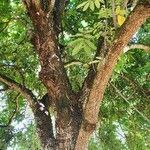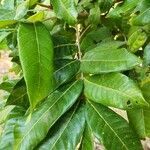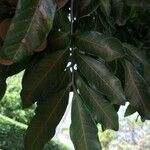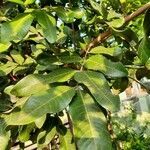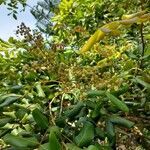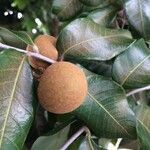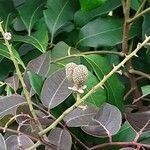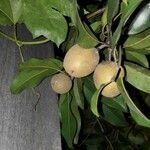Tree to 10 (–40) m high. Branchlets, leaf axes and inflorescence pubescent to puberulent; branchlets lenticellate. Leaf rachis to c. 12 cm long; leaflets opposite or subopposite, (4) 6 or 8 (10, 12), the lamina elliptic to narrowly elliptic or oblong–elliptic to obovate or lanceolate, obtuse to acute, entire, (3–) 4.5–12 (–15) cm long, 1.5–4 (–5) cm wide, glabrous above, with sparse minute stellate hairs below; glands rarely present along midrib, absent near margins; petiolules 2–5 mm long; petiole c. 1.5–3 cm long. Panicle axillary or terminal, 8–12 cm long, to 6 cm wide; cymules subsessile, scattered; pedicels to 1.5 mm long, pubescent. Calyx c. 4 mm long or ± as long as petals, green, white or cream, stellate-pubescent. Petals c. 3 mm long, white to cream, puberulent inside except glabrous apex, glabrous outside. Filaments 3.5–4.5 mm long, with erect hairs. Ovary 2-lobed; lobes globose, densely coarsely stellate-hairy, warty when mature. Fruit ±globular to ellipsoidal, 1.5–2.5 cm diam., surface ± smooth to shallowly textured in subsp. longan var. longan (conspicuously raised to warty in subsp. malesianus var. malesianus, echinate in var. echinatus), yellowish to pale brown with brownish flecks. Aril firm, fleshy, whitish translucent, enclosing a brown to blackish seed.
Trees, evergreen, usually ca. 10 m tall, sometimes to 40 m tall, ca. 1 m d.b.h. Branches strong, pilosulose, with scattered, glaucous lenticels. Leaves with petiole 15-30 cm or longer; leaflets (3 or)4 or 5(or 6) pairs; petiolules less than 5 mm; blades abaxially powdery green, adaxially deep green and shiny, oblong-elliptic to oblong-lanceolate, often bilaterally asymmetrical, 6-15 × 2.5-5 cm, thinly leathery, both surfaces glabrous, lateral veins 12-15 pairs, only prominent abaxially, base extremely asymmetrical, cuneate at side toward leaf base, broadly cuneate to truncate at side toward leaf apex, almost parallel to axis, apex acute, sometimes slightly obtuse. Inflorescences terminal or axillary near apex, large, many branched, densely stellate. Pedicels short. Calyx stellate; sepals triangular-ovate, ca. 2.5 mm, subleathery, both surfaces brownish yellow tomentose with tufts of stellate hairs. Petals 5, milky-white, lanceolate, nearly as long as sepals, only pilosulose abaxially. Filaments hirsute. Fruit usually yellowish brown or sometimes grayish yellow, subglobose, 1.2-2.5 cm in diam., abaxially slightly rugose, or with few slightly prominent tubercles. Seeds brown, nitid, with fleshy arillode. Fl. spring-summer, fr. summer.
Shrub or tree to 30 m tall; stems ferruginous-tomentose glabrescent. Leaves paripinnate; petiole plus rachis terete, 8-20.5 cm long, puberulent, smooth or striate; petiolules 4-5 mm long, puberulent; leaflets (2) 4-5 (9) pairs, opposite or subopposite, chartaceous or subcoriaceous, adaxially glabrous and lustrous, abaxially puberulent, and slightly paler than the adaxial surface, oblong to oblanceolate, 3-19 × 1.8-6 cm, the apex obtuse to subrounded, the base asymmetrical, obtuse-acute, the margins crenate, revolute. Inflorescences of axillary, paniculate thyrses 8-12 cm long, axes puberulent to tomentulose. Sepals ovate, 2-5 mm long, green, tomentulose; petals ca. 3 mm long, white, spatulate, adaxially pubescent; disc annular, pubescent; stamens 8, ca. 6 mm long, filaments densely pubescent at base. Fruits often developing a single, globose mericarp, ca. 1.2 cm long, pericarp coriaceous, sooth and granulate, tanish brown, glabrous, the inner surface glabrous, cream. Seeds nearly globose, ca. 1 cm long, dark brown to black, shiny, totally covered by a fleshy translucent aril, leaving a large semicircular hilum at base when removed.
A tree up to 12-40 m high with a low trunk and spreading branches. The tree has a rounded crown. It keeps its leaves throughout the year. The trunk can be 80 cm across. There can be buttresses 2 m tall. The bark is corky. The twigs have 5 faint grooves. The leaves are 3-45 cm long by 1.8-20 cm wide. The leaves have petioles and six to nine leaflets. Leaflets are up to 12 cm long. Young leaflets are often red before turning green. The flowers occur in upright clusters. These are 8-40 cm long. They are produced on new growth. The flowers are small and reddish-brown. A progression of male, female and hermaphrodite flowers occur. Flowers are pollinated by insects. The fruit is similar to a litchi and about 2.5 cm across. They are yellow-brown when mature and with a pebbly surface. They occur in clusters of 10 to 80. The flesh or aril is white and sweet. The seed is small, round and brownish-black. There are several named cultivated varieties.
